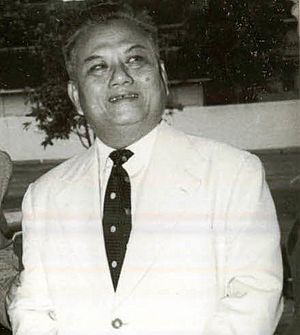Kaysone Phomvihane facts for kids
Quick facts for kids
Kaysone Phomvihane
|
|
|---|---|
|
ໄກສອນ ພົມວິຫານ
|
|

Kaysone Phomvihane in 1978
|
|
| 1st General Secretary of the Central Committee of the Lao People's Revolutionary Party (Party chair from 1991 to 1992) |
|
| In office 22 March 1955 – 21 November 1992 |
|
| Succeeded by | Khamtai Siphandon |
| 2nd President of Laos | |
| In office 15 August 1991 – 21 November 1992 |
|
| Prime Minister | Khamtai Siphandon |
| Preceded by | Phoumi Vongvichit (Acting) |
| Succeeded by | Nouhak Phoumsavanh |
| 11th Prime Minister of Laos | |
| In office 8 December 1975 – 15 August 1991 |
|
| President | Souphanouvong Phoumi Vongvichit (Acting) |
| Preceded by | Souvanna Phouma |
| Succeeded by | Khamtai Siphandon |
| Personal details | |
| Born |
Nguyễn Cai Song
13 December 1920 Savannakhet, French Indochina |
| Died | 21 November 1992 (aged 71) Vientiane, Laos |
| Political party | Lao People's Revolutionary Party |
| Spouse | Thongvin Phomvihane |
| Relatives | Santiphap (son) Sanyahak (son) Saysomphone (son) Thongsavanh (son) |
| a. General Secretary of the Central Committee of the Lao People's Party until February 1972; General Secretary of the Central Committee of the Lao People's Revolutionary Party until March 1991; Chairman of the Central Committee of the Lao People's Revolutionary Party since March 1991 | |
Kaysone Phomvihane (Lao: ໄກສອນ ພົມວິຫານ; December 13, 1920 – November 21, 1992) was a very important leader in Laos. He was the first head of the Lao People's Revolutionary Party, a communist political party, from 1955 until he passed away in 1992. After this party took control of Laos in 1975, he became the country's main leader. He served as the first Prime Minister of the Lao People's Democratic Republic from 1975 to 1991. Later, he became the second President from 1991 until his death in 1992.
Contents
Early Life and Education
Kaysone was born with the name Nguyễn Cai Song in Na Seng village, which was then part of French Indochina. Today, this area is known as Kaysone Phomvihane District in Savannakhet Province, Laos. His father, Nguyễn Trí Loan, was Vietnamese, and his mother, Nang Dok, was Lao. He also had two sisters.
He went to law school at University of Indochina in Hanoi. There, he studied alongside another future revolutionary, Nouhak Phoumsavanh. However, he left school early to join the fight against the French, who were ruling Vietnam at the time.
Becoming a Revolutionary Leader
Kaysone became very active in the revolutionary movement during the 1940s while he was studying in Hanoi. On January 20, 1949, he helped create the Lao People's Liberation Army (LPLA). He then became the Minister of Defense for the Resistance Government (Neo Lao Issara) starting in 1950.
In 1955, he played a key role in setting up the Lao People's Revolutionary Party (LPRP) in Xam Neua. After that, he became the leader of the Pathet Lao movement. For many years, he stayed mostly out of the public eye, while Prince Souphanouvong was the well-known face of the Pathet Lao. During these years, Kaysone led the communist forces against the Kingdom of Laos and the U.S. forces.
Leading Laos
Kaysone became the public leader of Laos in December 1975. This happened shortly after the Pathet Lao took control of Vientiane, the capital city. At a special meeting called the National Conference of People's Representatives, Kaysone announced that the monarchy (the system of having a king) was ending. He declared that Laos would become a republic instead.
The very next day, the conference accepted King Sisavang Vatthana's decision to step down. They officially ended the monarchy and announced the creation of the Lao People's Democratic Republic. Kaysone suggested that Souphanouvong become the first president, while he himself was named prime minister. He held the position of prime minister until 1991, when he became president. During this time, he married Thongvin Phomvihane.
Under Kaysone's leadership, Laos and Vietnam began to officially mark their border in 1977. This process was completed in 2007. Experts say this new border is very similar to the one the French had drawn in 1945.
According to Vatthana Pholsena, a professor who studies Southeast Asia, Kaysone was the main decision-maker and a very strong leader in the Lao People's Democratic Republic. He even created Sekong Province to thank the minority groups in the south for their help during the war.
Kaysone passed away in Vientiane on November 21, 1992. After his death, the government of Laos built a museum to honor him. Vietnam also helped fund the building of this museum. In 2012, his ashes were moved to a new National Cemetery.
Family Life
Kaysone had four sons: Saysomphone, Thongsavanh, Sanyahak, and Santiphap. All of his sons went on to hold important positions in the Lao People's Revolutionary Party.
- Saysomphone served as the President of the Lao Front for National Construction. He is currently the President of the National Assembly.
- Thongsavanh is in charge of the LPRP's External Relations Committee, which handles relationships with other countries.
- Sanyahak was chosen to be part of the LPRP Central Committee at the 8th LPRP Congress. He became a Major General at the age of 40 in 2008. Sadly, he passed away early on July 19, 2013, at the age of 45.
- Santiphap is currently the Governor of Savannakhet Province.
See also
 In Spanish: Kaysone Phomvihane para niños
In Spanish: Kaysone Phomvihane para niños
- Kaysone Phomvihane Museum
Images for kids
-
Kaysone Phomvihane on a 2000 kip banknote from 2011




